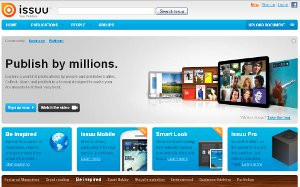
I was recently asked about using issuu.com as a tool for publishing print media on the web. While I found only a couple of minor things I didn't like about Issuu, mostly regarding zoom control, this question roused my general dislike for the practice of dumping printed material to a PDF file and slapping it on a website.
Content creators who insist on publishing this way either have a lack of understanding about the differences between web and print, or don't care. This sends a message (whether it's true or not) that the publisher only cares about getting their message out, and not about any real benefit for the reader.
The reality is that print and web are two different platforms, and content needs to be formatted differently for each. Usability expert Jakob Nielsen outlined the differences back in 1999, and most of what he said then still holds true today. Using fancy tools to render print content, no matter how well implemented, is no substitute for a properly considered web version. The issues aren't just constrained to layout, either. People read differently on the web than in print, and the actual writing should reflect that. As more and more users move from desktop and lap to mobile, this rift can only increase.
The challenge for designers and developers is that we can't really give users the ability to lay things out with the "ooh pretty" paradigm of print media without running huge risks of them breaking the site. (Largely because so many users try to do layout using crappy WYSIWYG tools and/or bad HTML habits we all learned in the 90's, and because they don't realize they need to test in all browsers.) So how do we keep the creatives happy without forcing them to learn the skills necessary for the level of design freedom they demand?
We can't, yet, but there are new techniques coming. We're going to see a lot of UX changes driven by the iPad, where gestures cause natural movement like page flip. Treesaver is a new standards-based process for displaying content in a more print-like manner with a pretty good degree of automation. It will first roll out when Nomad Editions launches (see demo video) and then be released as an open-source standard. At that point, it could probably be incorporated into Drupal sites, probably in the theme layer. Check out this episode of The Big Web Show podcast for further discussion and more information.
Even so, it's not the technology but the mentality that's causing problems. Innovators are finding ways to squeeze as much out of the available platforms as possible, and HTML5 holds a lot of promise for publishing in the future. But people simply sticking print media up on the web are still missing the point. They need to be educated about how and why the web is a different place where layout, process and attention span all affect the way we read, so they can adapt their content accordingly.